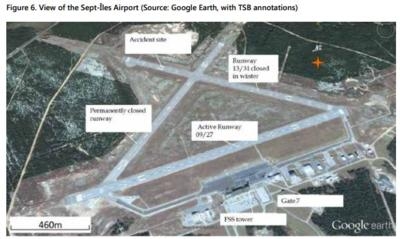Thu, Aug 06, 2015
Deviation From Approved Procedure During Training Flight Led To Accident
The Transportation Safety Board of Canada (TSB) has published its investigation report (A13Q0021) into an accident involving a helicopter training flight at the Sept-Îles Airport on February 3, 2013. The pilot instructor sustained serious injuries and the 2 pilots in training sustained minor injuries. The helicopter was heavily damaged.

The Eurocopter AS350 BA, operated by Héli-Excel Inc, was practicing various types of landings in unprepared areas. The aircraft then headed to the Sept-Îles Airport to undertake various simulated emergency exercises. At 0959 Eastern Standard Time, as the helicopter began its third hydraulic systems failure exercise, the flight instructor flew a short pattern at low altitude and low speed without hydraulic power. In the moments following the start of the final approach, the cyclic control stick moved sharply forward and to the left. The flight instructor gripped the cyclic stick to try and re-establish level flight. The main rotor blades struck the runway, and the aircraft came to a stop on its left side.
The investigation found that the approved procedure to complete this maneuver was not followed. As a result, the helicopter's flight profile deviated from the flight profile recommended by the manufacturer when the hydraulic system is depressurized. The investigation also found that in the absence of specific instructions for pilots regarding restoration of hydraulic pressure in the event of deviation from the flight profile, there is a risk that pilots will not be able to re-engage the hydraulic system while applying considerable effort to the helicopter controls.
The investigation made some other significant findings as to risk. First, the TSB has documented a number of cases where wearing a helmet would likely have reduced or prevented pilot injuries. Therefore, helicopter pilots who do not wear helmets are at increased risk of incapacitation, serious injuries or loss of life in the event of an accident. Secondly, the investigation revealed that there was no coordination of the emergency response. When emergency vehicles drive on an active runway without coordination between the airport operator and emergency response units, and with no means of communicating with the flight service station, there is a risk of collision on the runway.
(Image provided by TSB)
More News
Pilot Also Reported That Due To A Fuel Leak, The Auxiliary Fuel Tanks Were Not Used On June 4, 2025, at 13:41 eastern daylight time, a Piper PA-23, N2109P, was substantially damage>[...]
From 2023 (YouTube Edition): Reflections on War’s Collective Lessons and Cyclical Nature The exigencies of war ought be colorblind. Inane social-constructs the likes of racis>[...]
Pilot Reported That He Was Unfamiliar With The Single Seat Amateur-Built Airplane And His Intent Was To Perform High-Speed Taxi Testing Analysis: The pilot reported that he was unf>[...]
From 2023 (YouTube Edition): First Kits to Ship October 2023 Having formerly resurrected the storied shape of the Ryan ST—in effigy, anyway—Montrose, Colorado-based Tim>[...]
Performance-Based Navigation (PBN) [ICAO] Area navigation based on performance requirements for aircraft operating along an ATS route, on an instrument approach procedure or in a d>[...]
 NTSB Prelim: Piper PA-23
NTSB Prelim: Piper PA-23 Classic Aero-TV: One Mans Vietnam
Classic Aero-TV: One Mans Vietnam NTSB Final Report: Capella Aircraft Corp FW1C50
NTSB Final Report: Capella Aircraft Corp FW1C50 Classic Aero-TV: Timber Tiger Touts Curtiss Jenny Replicas
Classic Aero-TV: Timber Tiger Touts Curtiss Jenny Replicas ANN's Daily Aero-Term (07.04.25): Performance-Based Navigation (PBN) [ICAO]
ANN's Daily Aero-Term (07.04.25): Performance-Based Navigation (PBN) [ICAO]



